Canon EF 28 mm f/1.8 USM
4. Image resolution
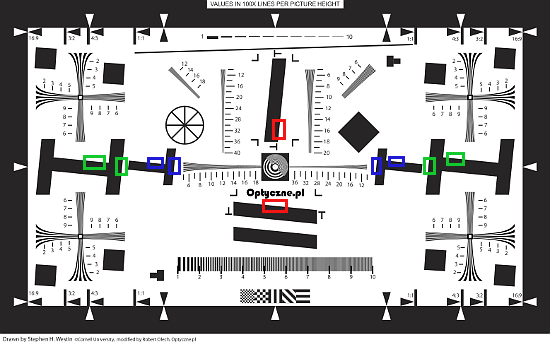
Resolution measurement areas in the frame centre are marked in red. In the case of Canon lenses’ tests the results we get on the EOS 1Ds MkIII are easily transformed into those we can obtain on the EOS 20D – they are simply by 1-2 lpmm lower. Areas marked in blue allow us to determine the quality of image at the edge of an APS-C/DX sensor using a full frame sensor camera. Green areas, for a change, give us a possibility to assess the resolution at the edge of full frame.
Please Support UsIf you enjoy our reviews and articles, and you want us to continue our work please, support our website by donating through PayPal. The funds are going to be used for paying our editorial team, renting servers, and equipping our testing studio; only that way we will be able to continue providing you interesting content for free. |
- - - - - - - - - - - - - - - - - - - - - - - - - - - - - - - - - - - - - - - - - - - - - - - -
Let’s see how it works in practice for the set of the EOS 1Ds MkIII and the EF 28 mm f/1.8 USM lens.
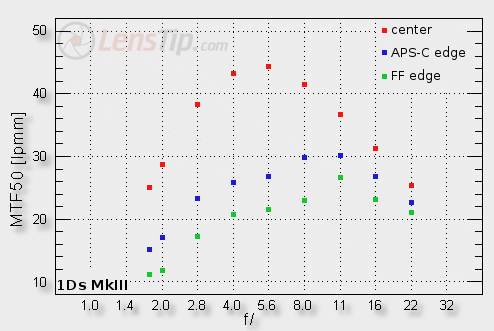
When it comes to the frame centre resolution results we can complain about the image quality near the maximum relative aperture. It is quite typical for older, fast fix-focal lenses and the Canon 1.8/28 is not an exception here. In the case of the 1 Ds MkIII camera the decency level, set by us, is near 31-32 lpmm. As you see by f/1.8 and f/2.0 the MTFs are below that value. If you want to enjoy fully useful photos you must stop the tested lens down to about f/2.2 – f/2.5. Fortunately on stopping down the image quality improves very quickly and the Canon fares very well for a 15-year-old construction. The lens reaches the maximum of its possibilities by f/5.6, where it nears 44 lpmm. This value is just slightly worse than in the case of the best, currently manufactured, prime lenses of the L class.
Let’s pass now to the APS-C sensor’s frame edge performance, which can be assessed looking at the blue points on the graph below. Not many old, wide angle lenses, still designed to work with photographic film, manage to get good results at the edge of a digital sensor. The tested Canon 1.8/28 is not an exception to this rule. In the f/1.8–2.8 aperture range the quality at the edge of the small sensor is simply weak and it never improves because even by f/8-11 we just brush against the level of 30 lpmm.
The real difficulties we encounter on the full frame sensor though, and, after all, the Canon 1.8/28 was designed to work on it. Still, even at the sharpest apertures the results are weak, reaching now and then just 26 lpmm.
This is the price you must pay for full frame. Fully efficient 21 million pixels on a 36x24 mm sensor demand a lot from the optics and small wonder older construction aren’t up to that standard.
In order to not sound hollow we would like to show you what can be expected in the full frame corners when you work with the Canon 1.8/28 – just have a look at our test chart crop, taken from the bottom right-hand corner of the frame.
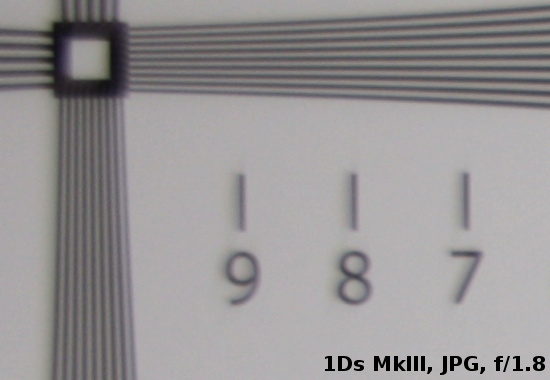 |
Luckily we can show that the test chart crops from the center don't look so bad like these from the corner.
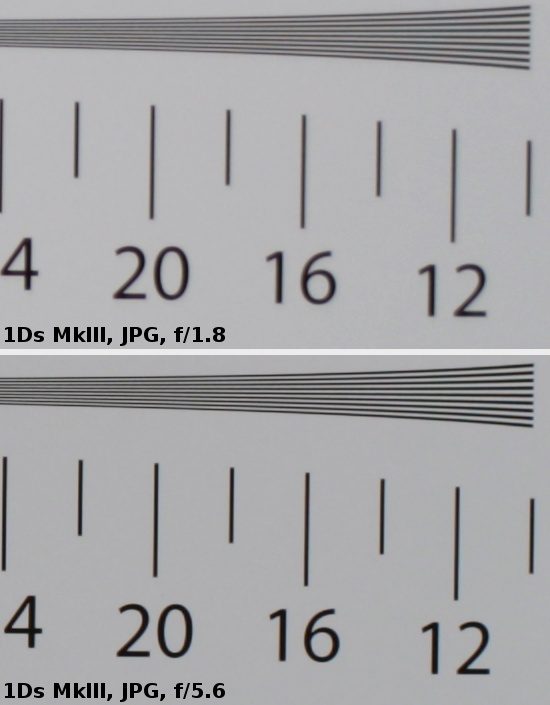 |
By and large we could have finished this chapter now. There’s just one “but”…we would finish it now if the EF-S lenses’ tests were still conducted on the 20D camera. For some time now we have been using a much more modern EOS 50D model and this camera’s pixel density is greater than in the case of a 20D and a 1Ds MkIII so it generates higher MTF values. In order to give our readers an opportunity to a better comparison of the results we decided to test the Canon 1.8/28 also on the 50D. In the end, the new charts, which were supposed to be a less labour-intensive way of testing lenses, made us in fact work even harder.
There are two comforting things, though. We performed two independent tests so we control our results better and we check our methods more thoroughly. What’s more, the graph below shows that the conclusions we drew and described earlier can’t and shouldn’t be changed. It gives us some hope – perhaps in future we will be able to save on some unnecessary procedures and we won’t have to test full frame lenses on the Canon’s 50D sensor.
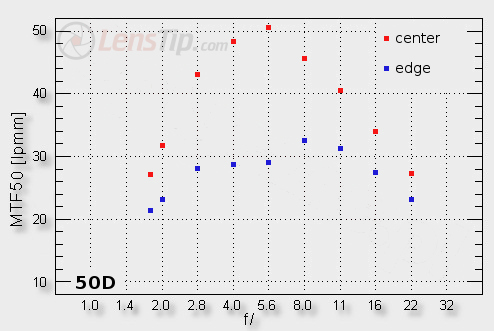
As we mentioned earlier, the 50D has pixels more densely packed than the 1Ds Mk III and the 20D cameras so it is easier for it to get higher MTF values with different lenses. That’s why, in its case, the decency borderline was moved near 34-35 lpmm. You can see that in the frame centre it is reached neither by f/1.8 nor by f/2.0 and the lens exceeds it only close to f/2.2-2.5 – the conclusion virtually identical as in the test performed on the 1Ds MkIII. We don’t conceal the fact that this similarity pleases us very much.
The frame edge conclusions are identical as well. The image is very weak in the wide areas near the maximum relative aperture and just starts brushing against decency borderline by f/8-f/11.
To sum up the elderly Canon EF 28 mm f/1.8 USM can certainly generate sharp images in the frame centre. The edges of densely packed sensors, either APS-C or FF, are too demanding for it, though, so the lens simply doesn’t cope there.






